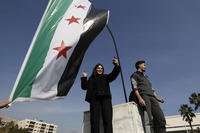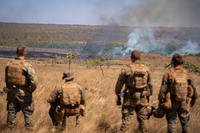Two retired Airmen were recently inducted into the NASA's Astronaut Hall of Fame during a ceremony May 5 at the Kennedy Space Center, Fla.
Retired Gen. Kevin Chilton and retired Col. Charles Precourt, along with Franklin Chang Diaz, were the 11th group of astronauts inducted, which brings the total number of astronauts in the hall of fame to 81.
"This is a tremendous honor," Precourt said. "It's obviously very humbling and I'm just really thrilled to be here today.
Precourt graduated from undergraduate pilot training at Reese Air Force Base, Texas, in 1978. Initially he flew as an instructor pilot in the T-37 Tweet, and later as a maintenance test pilot in the T-37 and T-38 Talon. In 1985, he attended the United States Air Force Test Pilot School at Edwards AFB, Calif. Upon graduation, Precourt was assigned as a test pilot at Edwards AFB, where he flew the F-15E Strike Eagle, F-4 Phantom, A-7 Corsair II, and A-37 Dragonfly until 1989, when he began studies at the United States Naval War College in Newport, R.I. Upon graduation from the War College, Precourt joined the astronaut program.
Precourt served in the space program for 15 years and was a mission specialist on Space Transportation System-55, pilot on STS-71, and commander on STS-84 and STS-91. During those missions he logged a total of 932 hours in space. During the STS-91 mission, which was the ninth and final Shuttle-Mir docking mission, the crew also conducted the Alpha Magnetic Spectrometer experiment, which involved first of its kind research of antimatter in space. He retired from the Air Force on March 31, 2000.
"It's incredibly humbling and unexpected," Chilton said. "I kind of had a sense that I didn't belong on the same list as these great folks. As I grew up, they were the ones I looked up to. They were my heroes. I kind of felt out of place, but at the same time incredibly grateful."
Chilton is the former commander of U.S. Strategic Command and a 1976 graduate of the Air Force Academy. He piloted the Space Shuttle Endeavour on its maiden voyage during the STS-49 mission, his first as an astronaut. Highlights of that mission included NASA's first three-person extravehicular activity during an operation to capture and repair a non-functional Intelsat VI satellite. He also piloted the 11-day STS-59 mission aboard Endeavour, which used radar imaging to map parts of the U.S., Europe and Asia for climate research.
The day before the ceremony, the astronauts and their families toured the space center, where Chilton and his wife, Brig. Gen. Cathy Chilton, the Air Force Academy's mobilization assistant, had the opportunity to sit in the cockpit of the Endeavour.
"It was really special being in (the Endeavour) with my wife because she had never been in there before," Chilton said. "She and all the other spouses are the real heroes of the program. They stand three miles away on top of a building at some ungodly hour of the morning with their babies in their arms watching their husband or wife sit on top of four million pounds of high explosives and blast off the planet. They're the really brave ones."
Chilton's career is different than many Airmen turned astronauts because after his career at NASA ended, he came back to the active duty Air Force in 1998.
"I don't think you could have laid it out on a piece of paper beforehand," he said. "To come back to the Air Force ... was something I always wanted to do but didn't think I could because the system wasn't set up to accommodate that, but it miraculously all changed at the right time."
His first duty upon returning to the Air Force was Air Force Space Command's deputy director of operations at Peterson Air Force Base, Colo. It culminated as the commander of U.S. Strategic Command at Offutt AFB, Neb.
"I couldn't have asked for better commands when I came back, and they were all exciting and each one just added on top of the next," Chilton said.
Chilton was a rated pilot with more than 5,000 flying hours in several airframes, including the F-4 Phantom, F-15 Eagle, B-52 Stratofortress and U-2 Dragon Lady. He retired Feb. 1, 2011.

























